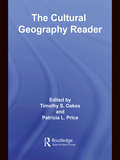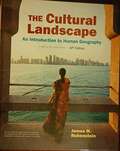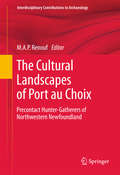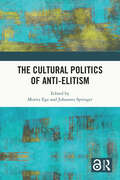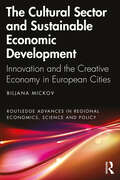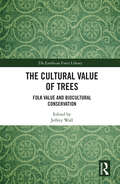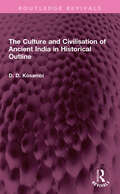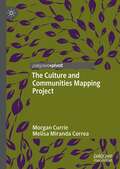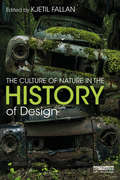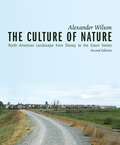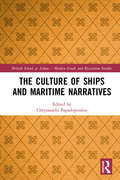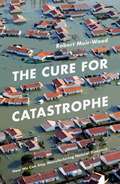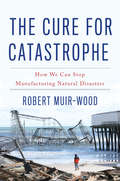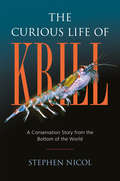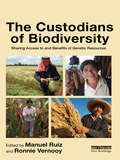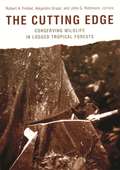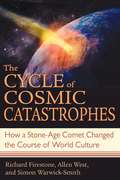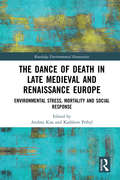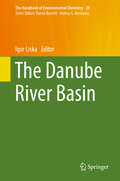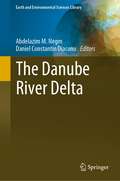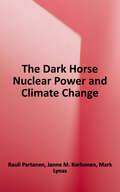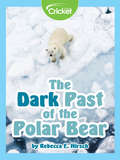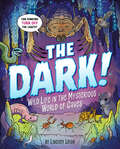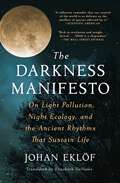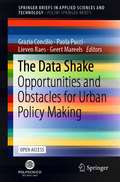- Table View
- List View
The Cultural Geography Reader
by Patricia L. Price Timothy OakesThe Cultural Geography Reader draws together fifty-two classic and contemporary abridged readings that represent the scope of the discipline and its key concepts. Readings have been selected based on their originality, accessibility and empirical focus, allowing students to grasp the conceptual and theoretical tools of cultural geography through the grounded research of leading scholars in the field. Each of the eight sections begins with an introduction that discusses the key concepts, its history and relation to cultural geography and connections to other disciplines and practices. Six to seven abridged book chapters and journal articles, each with their own focused introductions, are also included in each section. The readability, broad scope, and coverage of both classic and contemporary pieces from the US and UK makes The Cultural Geography Reader relevant and accessible for a broad audience of undergraduate students and graduate students alike. It bridges the different national traditions in the US and UK, as well as introducing the span of classic and contemporary cultural geography. In doing so, it provides the instructor and student with a versatile yet enduring benchmark text.
The Cultural Landscape: An Introduction To Human Geography
by James M. RubensteinThe Cultural Landscape: An Introduction to Human Geography AP Edition
The Cultural Landscapes of Port au Choix
by M. A. RenoufNewfoundland lies at the intersection of arctic and more temperate regions and, commensurate with this geography, populations of two Amerindian and two Paleoeskimo cultural traditions occupied Port au Choix, in northern Newfoundland, Canada, for centuries and millennia. Over the past two decades The Port au Choix Archaeology Project has sought a comparative understanding of how these different cultures, each with their particular origin and historical trajectory, adapted to the changing physical and social environments, impacted their physical surroundings, and created cultural landscapes. This volume brings together the research of Renouf, her colleagues and her students who together employ multiple perspectives and methods to provide a detailed reconstruction and understanding of the long-term history of Port au Choix. Although geographically focussed on a northern coastal area, this volume has wider implications for understanding archaeological landscapes, human-environment interactions and hunter-gatherer societies.
The Cultural Politics of Anti-Elitism
by Moritz Ege Johannes SpringerThis book examines the highly ambivalent implications and effects of anti-elitism. It draws on this theme as a cross-cutting entry point to provide transdisciplinary analysis of current conjunctures and their contradictions, drawing on examples from popular culture and media, politics, fashion, labour and spatial arrangements. Using the toolboxes of media and discourse analysis, hegemony theory, ethnography, critical social psychology and cultural studies more broadly, the book surveys and theorizes the forms, the implications and the ambiguities and limits of anti-elitist formations in different parts of the world. Anti-elitist sentiments colour the contemporary political conjuncture as much as they shape pop cultural and media trends. Populists, right-wing authoritarian ones and others, direct their anger at cultural, political and, sometimes, economic elites while supporting other elites and creating new ones. At the same time, "elitist" knowledge and expertise, decision-making power and taste regimes are being questioned in societal transformations that are discussed much more positively under headlines such as participation or democratization. The book brings together a group of international, interdisciplinary case studies in order to better understand the ways in which the battle cry "against the elites" shapes current conjunctures and possible future politics, focusing on themes such as nationalist political discourse in India, Austria, the UK and Hungary, labour struggles and anti-oligarchy rhetoric in Russia, tax-avoiding elites and fiscal imaginaries, working-class agency, Melania Trump as a celebrity narrative in Slovenia, aesthetic codes of the Alt-Right, football hooliganism in Germany, "hipster hate" in German political discourse or the politics of expertise and anti-elite iconography in high fashion internationally. The book is intended for undergraduates, postgraduates and postdoctoral researchers.
The Cultural Sector and Sustainable Economic Development: Innovation and the Creative Economy in European Cities (Routledge Advances in Regional Economics, Science and Policy)
by Biljana MickovThe cultural sector plays an important role in sustainable economic development and creates economic activities, opportunities for entrepreneurship and jobs, adding to the attractiveness of cities and contributing to the development of tourism. The Cultural Sector and Sustainable Economic Development: Innovation and the Creative Economy in European Cities offers both a theoretical and practical analysis of the contemporary approach to culture and innovation, with special emphasis on the relationships among culture, innovation and the economy. Sustainable development, itself, balances environmental protection, culture, social progress, the economy and stability today and for the future. The book’s key theme is the role and possibility of culture as a laboratory, with a strong supporting subtext on innovative practice. The text provides an eclectic mix of possibilities that reinforce and underscore the full innovative and complex potentials of culture. It is a cross-disciplinary volume presenting case studies that cover the main theme of cultural ecosystem in a very broad sense, highlighting the relationships that could lead to a sustainable system where economy and culture are the main players. It proposes and maps the European perspective of urban cultural development and suggests that the successes and challenges of European cities under consideration may offer guidance on best practices for urban development in other distant cultural contexts. This book is written in such a way that it can be used as a summary for a cultural professional, a reference text for an academic or for actors in local development and cultural policy at European, national and local levels.
The Cultural Value of Trees: Folk Value and Biocultural Conservation (The Earthscan Forest Library)
by Jeffrey WallThis volume focuses on the tree, as a cultural and biological form, and examines the concept of folk value and its implications for biocultural conservation. Folk value refers to the value of the more-than-human living world to cultural cohesion and survival, as opposed to individual well-being. This field of value, comprising cosmological, aesthetic, eco-erotic, sentimental, mnemonic value and much more, serves as powerful motivation for the local performance of environmental care. The motivation to maintain and conserve ecology for the purpose of cultural survival will be the central focus of this book, as the conditions of the Anthropocene urgently require the identification, understanding and support of enduring, self-perpetuating biocultural associations. The geographical scope is broad with chapters discussing different tree species from the Americas and the Caribbean, East Asia, Eurasia and Australia and Africa. By focusing on the tree, one of the most reliably cross-culturally-valued and cross-culturally-recognized biological forms, and one which invariably defines expansive landscapes, this work illuminates how folk value binds the survival of more-than-human life forms with the survival of specific peoples in the era of biocultural loss, the Anthropocene. As such, this collection of cross-cultural cases of tree folk value represents a low hanging fruit for the larger project of exploring the power of cultural value of the more-than-human living world. This book will be of great interest to students and scholars of conservation, biodiversity, biocultural studies and environmental anthropology.
The Culture and Civilisation of Ancient India in HIstorical Outline (Routledge Revivals)
by D D KosambiFirst published in 1965, The Culture and Civilisation of Ancient India in Historical Outline is a strikingly original work, the first real cultural history of India. The main features of the Indian character are traced back into remote antiquity as the natural outgrowth of historical process. Did the change from food gathering and the pastoral life to agriculture make new religions necessary? Why did the Indian cities vanish with hardly a trace and leave no memory? Who were the Aryans – if any? Why should Buddhism, Jainism, and so many other sects of the same type come into being at one time and in the same region? How could Buddhism spread over so large a part of Asia while dying out completely in the land of its origin? What caused the rise and collapse of the Magadhan empire; was the Gupta empire fundamentally different from its great predecessor, or just one more ‘oriental despotism’? These are some of the many questions handled with great insight, yet in the simplest terms, in this stimulating work. This book will be of interest to students of history, sociology, archaeology, anthropology, cultural studies, South Asian studies and ethnic studies.
The Culture and Communities Mapping Project
by Morgan Currie Melisa Miranda CorreaThis book describes three years of work by the Culture and Communities Mapping Project, a research project based in Edinburgh that uses maps as an object of study and also a means to facilitate research. Taking a self-reflexive approach, the book draws on a variety of iterative mapping procedures and visual methodologies, from online virtual tours to photo elicitation, to capture the voices of inhabitants and their distinctive perspectives on the city. The book argues that practices of cultural mapping consist of a research field in and of itself, and it situates this work in relation to other areas of research and practice, including critical cartography, cultural geography, critical GIS, activist mapping and artist maps. The book also offers a range of practical approaches towards using print and web-based maps to give visibility to spaces traditionally left out of city representations but that are important to the local communities that use them. Throughout, the authors reflect critically on how, through the processes of mapping, we create knowledge about space, place, community and culture.
The Culture of Nature in the History of Design
by Kjetil FallanThe Culture of Nature in the History of Design confronts the dilemma caused by design’s pertinent yet precarious position in environmental discourse through interdisciplinary conversations about the design of nature and the nature of design. Demonstrating that the deep entanglements of design and nature have a deeper and broader history than contemporary discourse on sustainable design and ecological design might imply, this book presents case studies ranging from the eighteenth to the twenty-first century and from Singapore to Mexico. It gathers scholarship on a broad range of fields/practices, from urban planning, landscape architecture, and architecture, to engineering design, industrial design, furniture design and graphic design. From adobe architecture to the atomic bomb, from the bonsai tree to Biosphere 2, from pesticides to photovoltaics, from rust to recycling – the culture of nature permeates the history of design. As an activity and a profession always operating in the borderlands between human and non-human environments, design has always been part of the environmental problem, whilst also being an indispensable part of the solution. The book ventures into domains as diverse as design theory, research, pedagogy, politics, activism, organizations, exhibitions, and fiction and trade literature to explore how design is constantly making and unmaking the environment and, conversely, how the environment is both making and unmaking design. This book will be of great interest to a range of scholarly fields, from design education and design history to environmental policy and environmental history.
The Culture of Nature: North American Landscape from Disney to Exxon Valdez
by Alexander WilsonSince it was first published in 1991, few books have come close to capturing the depth and breadth of Alexander Wilson’s innovative ecocultural compendium The Culture of Nature. His work was one of the first of its kind to investigate the ideology of the environment, to critique the future according to Disney, and illustrate that the ways we think, teach, talk about, and construct the natural world are as important a terrain as the land itself. Extensively illustrated and meticulously researched, this edition is exquisitely revised and reissued for the Anthropocene.
The Culture of Ships and Maritime Narratives (British School at Athens - Modern Greek and Byzantine Studies #7)
by Chryssanthi PapadopoulouThe ship transcends the descriptive categories of place, vehicle and artefact; it is a cosmos, which requires its own cosmology. This is the subject matter of this volume, which falls within the broader, flourishing sub-field of maritime anthropology. Specifically, the volume first investigates the dialectic between the sea, the ship and the ship-dweller and shows how traits are exchanged between the three. It then focuses on land-dwellers, their understanding of seaborne existence and their invaluable contribution to the culture of ships. It shows that the romanticised views of life at sea that land-dwellers hold constitute an important aspect of the cosmology of ships and they too need to be considered if the polyvalence of ships is to be fully understood. In order for this cosmology to be written, some of the volume’s contributors have travelled on ships and interviewed mariners, fishermen, boat-builders and boat-dwellers; others have traced the courses of ships in poems, films, philosophical texts, and collective myths of genealogy and heritage. Overall the volume shows where ships can go, and how they are perceived and experienced by those living and travelling in them, watching and waiting for them, dreaming and writing about them, and, finally, what literal and metaphorical crews man them.
The Cure for Catastrophe: How We Can Stop Manufacturing Natural Disasters
by Robert Muir-WoodWhy did no one consider that a tsunami could disable the nuclear power plant in Fukushima? Why did so many die when Katrina flooded New Orleans? Not so long ago we could only focus on rescuing and sheltering survivors - now we can anticipate many natural disasters and plan for them. In dozens of cities around the world, we're able to identify the specific buildings that will be shaken apart, blown down or reduced to rubble. Yet every year, for reasons of politics and inertia, we fail to act. Despite a revolution in our understanding of these catastrophes, since 2000 they've killed more people than ever before.Taking us on a fascinating journey through the history of catastrophe science, with forensic examinations of the most devastating cataclysms in living memory, Robert Muir-Wood provides a riveting account of our attempts to tame the most extreme forces of nature. Combining a global span with insights from the latest climate and catastrophe modelling, The Cure for Catastrophe explores the extraordinary opportunity we now have to transform what we build, where we live and how warnings are communicated - decisions that could save millions of lives.
The Cure for Catastrophe: How We Can Stop Manufacturing Natural Disasters
by Robert Muir-WoodWe can't stop natural disasters but we can stop them being disastrous. One of the world's foremost risk experts tells us how.Year after year, floods wreck people's homes and livelihoods, earthquakes tear communities apart, and tornadoes uproot whole towns. Natural disasters cause destruction and despair. But does it have to be this way?In The Cure for Catastrophe, global risk expert Robert Muir-Wood argues that our natural disasters are in fact human ones: We build in the wrong places and in the wrong way, putting brick buildings in earthquake country, timber ones in fire zones, and coastal cities in the paths of hurricanes. We then blindly trust our flood walls and disaster preparations, and when they fail, catastrophes become even more deadly. No society is immune to the twin dangers of complacency and heedless development.Recognizing how disasters are manufactured gives us the power to act. From the Great Lisbon Earthquake of 1755 to Hurricane Katrina, The Cure for Catastrophe recounts the ingenious ways in which people have fought back against disaster. Muir-Wood shows the power and promise of new predictive technologies, and envisions a future where information and action come together to end the pain and destruction wrought by natural catastrophes. The decisions we make now can save millions of lives in the future.Buzzing with political plots, newfound technologies, and stories of surprising resilience, The Cure for Catastrophe will revolutionize the way we conceive of catastrophes: though natural disasters are inevitable, the death and destruction are optional. As we brace ourselves for deadlier cataclysms, the cure for catastrophe is in our hands.
The Curious Life of Krill: A Conservation Story from the Bottom of the World
by Stephen NicolKrill-it's a familiar word that conjures oceans, whales, and swimming crustaceans. Scientists say they are one of most abundant animals on the planet. But when pressed, few people can accurately describe krill or explain their ecological importance. Antarctic krill have used their extraordinary adaptive skills to survive and thrive for millions of years in a dark, icy world far from human interference. But with climate change melting ice caps at the top and bottom of the world, and increased human activity and pollution, their evolutionary flexibility to withstand these new pressures may not be enough.Eminent krill scientist Stephen Nicol wants us to know more about this enigmatic creature of the sea. He argues that it's critical to understand krill's complex biology in order to protect them as the krill fishing industry expands. This account of Antarctic krill-one of the largest of eighty-five krill species-takes us to the Southern Ocean to learn firsthand the difficulties and rewards of studying krill in its habitat. Nicol lays to rest the notion that krill are simply microscopic, shrimplikewhale food but are in fact midway up the food chain, consumers of phytoplankton and themselves consumed by whales, seals, and penguins. From his early education about the sex lives of krill in the Bay of Fundyto a krill tattoo gone awry, Nicol uses humor and personal stories to bring the biology and beauty of krill alive. In the final chapters, he examines the possibility of an increasingly ice-free Southern Ocean and what that means for the fate of krill-and us.Ocean enthusiasts will come away with a newfound appreciation for the complex ecology of a species we have much to learn from, and many reasons to protect.
The Custodians of Biodiversity: Sharing Access to and Benefits of Genetic Resources
by Ronnie Vernooy Manuel RuizGlobally, local and indigenous approaches to conserving biodiversity, crop improvement, and managing precious natural resources are under threat. Many communities have to deal with 'biopiracy,' for example. As well, existing laws are usually unsuitable for protecting indigenous and traditional knowledge and for recognizing collective rights, such as in cases of participatory plant breeding, where farmers, researchers and others join forces to improve existing crop varieties or develop new ones, based on shared knowledge and resources. This book addresses these issues. It outlines the national and international policy processes that are currently underway to protect local genetic resources and related traditional knowledge and the challenges these initiatives have faced. In particular these themes are addressed within the context of the Convention of Biological Diversity and the International Treaty on Plant Genetic Resources for Food and Agriculture. The authors broaden the policy and legal debates beyond the sphere of policy experts to include the knowledge-holders themselves. These are the 'custodians of biodiversity': farmers, herders and fishers in local communities. Their experience in sharing access and benefits to genetic resources is shown to be crucial for the development of effective national and international agreements. The book presents and analyzes this experience, including case studies from China, Cuba, Honduras, Jordan, Nepal, Peru and Syria. Copublished with the International Development Research Centre (IDRC).
The Cutting Edge: Conserving Wildlife in Logged Tropical Forests
by John G. Robinson Alejandro Grajal Robert A. FimbelBringing together leading scientists and professionals in tropical forest ecology and management, this book examines in detail the interplay between timber harvesting and wildlife, from invertebrates to large mammal species. Its contributors suggest modifications to existing practices that can ensure a better future for the tropics' valuable--and invaluable--resources.
The Cycle of Cosmic Catastrophes: How a Stone-Age Comet Changed the Course of World Culture
by Allen West Richard Firestone Simon Warwick-SmithNewly discovered scientific proof validating the legends and myths of ancient floods, fires, and weather extremes• Presents new scientific evidence revealing the cause of the end of the last ice age and the cycles of geological events and species extinctions that followed• Connects physical data to the dramatic earth changes recounted in oral traditions around the world • Describes the impending danger from a continuing cycle of catastrophes and extinctionsThere are a number of puzzling mysteries in the history of Earth that have yet to be satisfactorily explained by mainstream science: the extinction of the dinosaurs, the vanishing of ancient Indian tribes, the formation of the mysterious Carolina Bays, the disappearance of the mammoths, the sudden ending of the last Ice Age, and the cause of huge underwater landslides that sent massive tsunamis racing across the oceans millennia ago. Eyewitness accounts of these events are chronicled in rich oral traditions handed down through generations of native peoples. The authors’ recent scientific discoveries link all these events to a single cause.In The Cycle of Cosmic Catastrophes Richard Firestone, Allen West, and Simon Warwick-Smith present new scientific evidence about a series of prehistoric cosmic events that explains why the last Ice Age ended so abruptly. Their findings validate the ubiquitous legends and myths of floods, fires, and weather extremes passed down by our ancestors and show how these legendary events relate to each other. Their findings also support the idea that we are entering a thousand-year cycle of increasing danger and possibly a new cycle of extinctions.
The Dance of Death in Late Medieval and Renaissance Europe: Environmental Stress, Mortality and Social Response (Routledge Environmental Humanities)
by Kathleen Pribyl Andrea KissThis volume investigates environmental and political crises that occurred in Europe during the late Middle Ages and the early Modern Period, and considers their effects on people’s lives. At this time, the fragile human existence was imagined as a ‘Dance of Death’, where anyone, regardless of social status or age, could perish unexpectedly. This book covers events ranging from cooling temperatures and the onset of the Little Ice Age, to the frequent occurrence of epidemic disease, pest infestations, food shortages and famines. Covering the mid-fourteenth to mid-seventeenth centuries, this collection of essays considers a range of countries between Iceland (to the north), Italy (to the south), France (to the west) and the westernmost parts of Russia (to the east). This wide-reaching volume considers how deeply climate variability and changes affected and changed society in the late medieval to early modern period, and asks what factors, other than climate, interfered in the development of environmental stress and socio-economic crises. This book will be of great interest to students and scholars of Environmental and Climate History, Environmental Humanities, Medieval and Early Modern History and Historical Geography, as well as Climate Change and Environmental Sciences.
The Danube River Basin (The Handbook of Environmental Chemistry #39)
by Igor LiskaThis volume offers a comprehensive review of the chemical, biological and hydromorphological quality of the Danube. The first part examines the chemical pollution of surface waters, focusing on organic compounds (with special emphasis given to EU WFD priority substances and Danube River Basin specific pollutants), heavy metals and nutrients. Attention is also given to pollution of groundwater and drinking water resources by hazardous substances and to radioactivity in the Danube. The second part highlights the biology and hydromorphology of the Danube. It focuses on benthic macroinvertebrates, phytobenthos, macrophytes, fish, phytoplankton as well as microbiology, with chapters dedicated to gaps and uncertainties in the ecological status assessment and to invasive alien species. Further chapters dealing with the hydromorphology, sediment management and isotope hydrology complete the overall picture of the status of the Danube.
The Danube River Delta (Earth and Environmental Sciences Library)
by Abdelazim M. Negm Daniel Constantin DiaconuThis unique book presents for the first time the current status of the Danube River Delta, the challenges facing it, and proposed strategies to solve it. One of the biggest challenges is the human effects on the Danube Delta Environment and its lakes that work as sinks for natural and anthropogenic environmental changes, the water management and water flow variability and under climatic conditions including the extreme temperature and precipitation events based on RCMs output and the impact of sedimentation processes on the evolution of the Danube Delta. The book also contains the impact of wind and solar energy on the Delta. The book also presents the integrated approach for sustainable development of the Delta including the structural dynamics of the local economy, the role of tourism activities, integrated waste management in the Danube Delta Biosphere Reserve, demographic dynamics in the Delta, and the population health state. Also, a unique chapter on the opportunities of content exploitation as Language Learning Experiences is applied to Danube Delta. The book will be of great scientific interest to help the graduate students, researchers, stakeholder professional engineers, policy planners, policymakers of three countries to implement their sustainable development plan.
The Dark Horse: Nuclear Power and Climate Change
by Rauli Partanen Janne M. KorhonenClimate scientists consider climate change to be among top threats to humanity’s future. If unchecked, runaway climate change can destroy not just many of our current ecosystems, but wreak havoc in human societies as well. To prevent the worst catastrophe, greenhouse gas emissions from our energy system needs to decline to zero rapidly. We need to replace fossil fuels, which represent roughly 85 % of our energy production, with low-carbon alternatives. To manage this in a low-risk and timely manner, all tools need to be utilized to their maximum potential, including nuclear energy. Nuclear is surrounded by colourful rhetoric, politics, fear and fearmongering, click-bait scandal-headlines and mental images of dangerous radiation and catastrophic accidents. But how much of this is warranted, and how much is based on beliefs, opinions and prejudices? How dangerous is ionizing radiation really? What happened in Chernobyl and Fukushima, and what are the best estimates on their effects on public health and the environment? And can we harness nuclear energy to play a major role in decarbonizing our energy systems rapidly and more affordably? This book takes a serious look how the climate change mitigation is progressing, what needs to be done, and how nuclear has helped in the past, and can help us in the future. Partanen is an award-winning science writer and analyst on climate, environment, energy and society. Korhonen did his PhD in the history of technology, has written about climate and energy for years and is currently researching “Plan B”, an emergency program for climate change mitigation.
The Dark Past of the Polar Bear
by Rebecca E. HirschPolar bears rule the frozen sea, but their ancestors weren't always built for ice and snow.
The Dark!: Wild Life in the Mysterious World of Caves
by Lindsey LeighCrawl into the deepest corners of caves across the world and learn about the wonderfully weird creatures that live their lives in the dark!Did you know that some creatures that live in the dark have adapted to have no eyes? Or that some dark dwellers have extra long antennae so they can feel their way around their homes? Have you ever seen a troglobite? There many different types of troglobites including the fearless waterfall-climbing cave fish, the mutant Mexican tetra, and the mystifying olm.Author and illustrator Lindsey Leigh introduces young readers to some of the weirdest and creepiest critters that thrive in the darkest corners of our planet in her uniquely funny and graphic style. This fact-filled book reveals the different ways that creatures of the dark have adapted to thrive in their environments, including slow movement and loss of pigment in their bodies to blend in with their surroundings. Readers will get to know aquatic cave leeches, tailless whip scorpions, cave beetles, the devil&’s hole pupfish, worms, salamanders, and all kinds of bats.Praise for Lindsey Leigh's The Deep!&“A buoyant undersea venture. Leigh draws her teeming wildlife in accurate detail.&”--Kirkus Reviews, starred review
The Darkness Manifesto: On Light Pollution, Night Ecology, and the Ancient Rhythms that Sustain Life
by Johan EklöfIn the bestselling tradition of Why We Sleep and The Sixth Extinction, an urgent and insightful look at the hidden impact of light pollution, and a passionate appeal to cherish natural darkness for the sake of the environment, our own well-being, and all life on earth.How much light is too much light? Satellite pictures show our planet as a brightly glowing orb, and in our era of constant illumination, light pollution has become a major issue. The world&’s flora and fauna have evolved to operate in the natural cycle of day and night. But in the last 150 years, we have extended our day—and in doing so have forced out the inhabitants of the night and disrupted the circadian rhythms necessary to sustain all living things, including ourselves. In this persuasive, well-researched book, Swedish conservationist Johan Eklöf urges us to appreciate natural darkness, its creatures, and its unique benefits. Eklöf ponders the beauties of the night sky, traces the errant paths of light-drunk moths and the swift dives of keen-eyed owls, and shows us the bioluminescent creatures of the deepest oceans. As a devoted friend of the night, he writes passionately about the startling damage we inflict on ourselves and our fellow creatures simply by keeping the lights on. The Darkness Manifesto depicts the domino effect of diminishing darkness: insects, dumbfounded by streetlamps, failing to reproduce; birds blinded and bewildered by artificial lights; and bats starving as they wait in vain for food insects that only come out in the dark of night. For humans, light-induced sleep disturbances impact our hormones and weight, and can contribute to mental health problems like chronic stress and depression. The streetlamps, floodlights, and neon signs of cities are altering entire ecosystems, and scientists are only just beginning to understand the long-term effects. The light bulb—long the symbol of progress and development—needs to be turned off. Educational, eye-opening, and ultimately encouraging, The Darkness Manifesto outlines simple steps that we can take to benefit ourselves and the planet. In order to ensure a bright future, we must embrace the darkness.
The Data Shake: Opportunities and Obstacles for Urban Policy Making (SpringerBriefs in Applied Sciences and Technology)
by Grazia Concilio Paola Pucci Lieven Raes Geert MareelsThis open access book represents one of the key milestones of PoliVisu, an H2020 research and innovation project funded by the European Commission under the call “Policy-development in the age of big data: data-driven policy-making, policy-modelling and policy-implementation”. It investigates the operative and organizational implications related to the use of the growing amount of available data on policy making processes, highlighting the experimental dimension of policy making that, thanks to data, proves to be more and more exploitable towards more effective and sustainable decisions. The first section of the book introduces the key questions highlighted by the PoliVisu project, which still represent operational and strategic challenges in the exploitation of data potentials in urban policy making. The second section explores how data and data visualisations can assume different roles in the different stages of a policy cycle and profoundly transform policy making.
